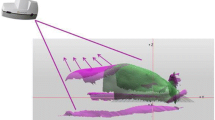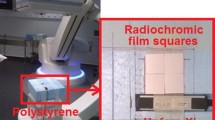Abstract
Background
Three-dimensional ultrasound (3D-US) is a modality complementary to kilovoltage cone beam computed tomography (kV-CBCT) and skin markers for patient positioning detection. This study compares the linearity of evaluations based on measurements using a modern 3D-US system (Elekta Clarity®; Elekta, Stockholm, Sweden), a kV-CBCT system (Elekta iView®), and skin markers.
Materials and methods
An investigator deliberately displaced a multimodal phantom by up to ± 30 mm along different axes. The following data points were acquired: 27 along the lateral axis, 29 along the longitudinal axis, 27 along the vertical axis, and 27 along the space diagonal. At each of these 110 positions, the displacements according to skin’ markers were recorded and scans were performed using both 3D-US and kV-CBCT. Shifts were detected by matching bony anatomy or soft tissue density to a reference planning CT in the case of kV-CBCT and for 3D-US, by matching ultrasound volume data to a reference planning volume. A consensus value was calculated from the average of the four modalities. With respect to this consensus value, the linearity (offset and regression coefficient, i.e., slope), average offset, systematic error, and random error of all four modalities were calculated for each axis.
Results
Linearity was similar for all four modalities, with regression coefficients between 0.994 and 1.012, and all offsets below 1 mm. The systematic errors of skin markers and 3D-US were higher than for kV-CBCT, but random errors were similar. In particular, 3D-US demonstrated an average offset of 0.36 mm to the right, 0.08 mm inferiorly, and 0.15 mm anteriorly; the systematic error was 0.36 mm laterally, 0.35 mm longitudinally, and 0.22 mm vertically; the random error was 0.15 mm laterally, 0.30 mm longitudinally, and 0.12 mm vertically. A total of 109 out of 110 (99 %) 3D-US measurements were within 1 mm of the consensus value on either axis.
Conclusion
The linearity of 3D-US was no worse than that of skin markers or kV-CBCT. Average offsets, systematic errors, and random errors were all below 1 mm. Optimal margins in the order of 1 mm could be achieved in the controlled laboratory setting of this phantom study.
Zusammenfassung
Hintergrund
Dreidimensionaler Ultraschall (3D-US) kann Hautmarkierungen und Bildgebung mittels Fächerstrahl-CT (kV-CBCT) während der Lagerungskontrolle ergänzen. Die vorliegende Untersuchung vergleicht die Linearität der Lagerungskontrolle basierend auf Messungen mit einem 3D-US-System (Elekta Clarity®, Elekta, Stockholm, Schweden) mit einem kV-CBCT-System (Elekta iView®) und mittels Hautmarkierungen.
Material und Methoden
Ein multimodales Phantom, das sowohl für die Bildgebung mit 3D-US als auch mit kV-CBCT geeignet ist, wurde vom Experimentator um bis zu ± 30 mm in verschiedene Richtungen aus der Nulllage verschoben. Dabei wurden 27 Punkte auf der lateralen, 29 Punkte auf der longitudinalen und 27 Punkte auf der vertikalen Achse sowie 27 Punkte auf der Raumdiagonalen gemessen. An jeder der insgesamt 110 Positionen wurde die Lage laut Hautmarkierungen abgelesen und abwechselnd Bilder mit 3D-US und mit kV-CBCT aufgenommen. Aus dem Vergleich der Bilder mit den jeweiligen Referenzaufnahmen wurden Verschiebewerte anhand der Lage von Knochenäquivalenten oder Weichgewebsäquivalenten bestimmt. Aus dem Mittelwert der vier Modalitäten wurde ein Konsenswert gebildet. Verglichen mit diesem Konsenswert wurden die Linearität (Steigung und Achsenabschnitt), die durchschnittliche Abweichung, der systematische und der zufällige Fehler aller vier Modalitäten für jede Achse bestimmt.
Ergebnisse
Die Linearität aller vier Modalitäten war vergleichbar, mit Steigungen zwischen 0,994 und 1,012 und allen Achsenabschnitten unterhalb 1 mm. Der systematische Fehler von Hautmarkierungen und 3D-US lag höher als derjenige von kV-CBCT, aber der zufällige Fehler war vergleichbar. Was 3D-US im Einzelnen angeht, so betrug die mittlere Abweichung vom Konsenswert 0,36 mm nach rechts, 0,08 mm nach inferior und 0,15 mm nach anterior. Sein systematischer Fehler betrug 0,36 mm lateral, 0,35 mm longitudinal und 0,22 mm vertikal. Der zufällige Fehler betrug 0,15 mm lateral, 0,30 mm longitudinal und 0,12 mm vertikal. 109 von 110 Messungen mit 3D-US (99 %) lagen innerhalb 1 mm um den Konsenswert für jede Achse.
Schlussfolgerung
Die Linearität des 3D-US war nicht schlechter als diejenige des kV-CBCT oder der Hautmarkierungen. Durchschnittliche Abweichungen, systematische Fehler und statistische Fehler waren alle geringer als 1 mm. In dieser Phantomstudie konnten in einer kontrollierten Laborumgebung optimale Sicherheitssäume von der Größenordnung 1 mm erreicht werden.

Similar content being viewed by others
References
Bohrer et al (2008) Reduced rectal toxicity with ultrasound-based image guided radiotherapy using BAT (B-mode acquisition and targeting system) for prostate cancer. Strahlenther Onkol 184(12):674–678
Pinkawa et al (2008) Image-guided radiotherapy for prostate cancer. Implementation of ultrasound-based prostate localization for the analysis of inter- and intrafraction organ motion. Strahlenther Onkol 184(12):679–685
Chadha M, Young A, Geraghty C, Masino R, Harrison L (2011) Image guidance using 3D-ultrasound (3D-US) for daily positioning of lumpectomy cavity for boost irradiation. Radiat Oncol 6:45
Ballhausen et al (2013) The random walk model of intrafraction movement. Physics in Medicine and Biology 58:2413–2427
Ballhausen et al (2015) Intra-fraction motion of the prostate is a random walk. Physics in Medicine and Biology 60:549–563
Wong P, Muanza T, Reynard E, Robert K, Barker J, Sultanem K (2011) Use of three-dimensional ultrasound in the detection of breast tumor bed displacement during radiotherapy. Int J Radiat Oncol Biol Phys 79:39–45
Robinson D, Liu D, Steciw S, Field C, Daly H, Saibishkumar EP, Fallone G, Parliament M, Amanie J (2012) An evaluation of the Clarity 3D ultrasound system for prostate localization. J Appl Clin Med Phys 13:3753
van der Meer S, Bloemen-van Gurp E, Hermans J, Voncken R, Heuvelmans D, Gubbels C, Fontanarosa D, Visser P, Lutgens L, van Gils F, Verhaegen F (2013) Critical assessment of intramodality 3D ultrasound imaging for prostate IGRT compared to fiducial markers. Med Phys 40:071707
Ballhausen H, Hieber S, Li M, Belka C, Reiner M (2014) Millimeter precision in ultrasound based patient positioning: experimental quantification of inherent technical limitations. Med Phys 41:081718
van Herk M, Remeijer P, Lebesque JV (2002) Inclusion of geometric uncertainties in treatment plan evaluation. Int J Radiat Oncol Biol Phys 52 1407–1422
Author information
Authors and Affiliations
Corresponding author
Ethics declarations
Conflict of interest
Elekta Germany supports research at the university hospital of the Ludwig-Maximilians-University, chair of Professor C. Belka. Elekta supported various congress presentations by Professor C. Belka. While funding for research with the Clarity system was received from Elekta, Elekta had no influence on study design or collection, analysis, or interpretation of data; nor did Elekta have any influence on the writing of the manuscript or the decision to submit the manuscript for publication. H. Ballhausen, S. Hieber, M. Li, K. Parodi, and M. Reiner state that there are no conflicts of interest. The accompanying manuscript does not include studies on humans or animals.
Rights and permissions
About this article
Cite this article
Ballhausen, H., Hieber, S., Li, M. et al. Linearity of patient positioning detection. Strahlenther Onkol 191, 442–447 (2015). https://doi.org/10.1007/s00066-015-0811-9
Received:
Accepted:
Published:
Issue Date:
DOI: https://doi.org/10.1007/s00066-015-0811-9




